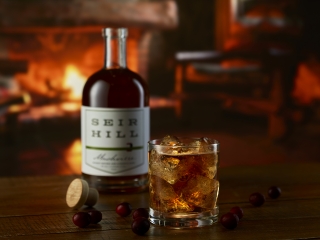
Spiritless Spirits are More Than Just a Dream
01 December 2022Non-alcoholic beverage market increases as better-tasting products serve a health-conscious drinker. Help culinary students perfect their beverage palates with non-alcohol alternatives.
By Lisa Parrish, GMC Editor
Feedback & comments: This email address is being protected from spambots. You need JavaScript enabled to view it.
Dry January is coming and perhaps the timing is right to introduce culinary students to the burgeoning market of non-alcoholic spirits, beer and wine.
Alcohol is big business in the United States, valued at more than $261 billion last year. It seems that the relatively low non-alcohol beverage sales – those with less than .05 percent alcohol by volume – of $395 million are a small drop in the beverage bucket. However, the market has seen double-digit growth for the last three years, with this year checking in at 20.6 percent growth versus a year ago, according to NielsenIQ.
Last year, Dry January 2022 saw 19 percent more adults participating in the US than during the previous year. According to a Morning Consult article, “Ninety-one percent of Dry January participants this year said they’ve committed because they are trying to be healthier, while 70 percent and 62 percent, respectively, said they are trying to cut down on drinking or want to reset their drinking in the new year.”
Health and taste drive the increase in alcohol-free beverages
One of the most up-and-coming companies serving the non-alcohol drinker is the Athletic Brewing Company, which is ranked as the 27th largest Brewers Association-defined craft brewery by volume. Last year the company saw a 177 percent increase in barrel production year-over-year. This brewery’s name defines its mission. According to the website, “It was inspired by our two core loves – a love for an active, healthy lifestyle and a love for great beer. And since day one, Athletic Brewing’s mission has been to combine them both without compromising on either.”
The co-founder of the company, Bill Shufelt, was an avid runner and wanted to market his beer to like-minded people. According to an article in The Zero Proof, “Bill saw himself as the target customer. ‘My hypothesis was if I ran these races like I normally would, I didn't have to form a focus group (Bill said).’ Instead, he could just meet them at the finish line with a cold beer. ‘People were happy, sweaty and thirsty, and then here's this other person who had just run the race with them, and was like, 'Here, try my beer, I made this.'’ … The personal touch, along with the unusually delicious beer, worked.”
Good taste and health-conscious drinkers are also the driving forces behind non-alcoholic spirit producer Sier Hill. The company produces a whiskey, tequila and rum alternative. The products are either low in or free of calories, sugar, gluten, allergens and are all vegan. Also, their products are meant as beverage mixers and not to be consumed straight with no additional ingredients – in other words neat.
 According to Brian Miller, Sier Hill founder and master distiller, 82 percent of people who purchase a spirit intend to mix it whereas 18 percent drink the spirit neat. He used his company’s Mashville Non-Alcoholic Whiskey Alternative as an example of how they engineer their products to mimic the aromas and flavors of the drink’s spirited cousins. “It’s difficult to replicate the bite (of alcohol),” he said. To replicate the burn, some producers use peppers and “then all you taste is pepper.” Sier Hill uses a nuanced approach to creating a whiskey alternative that tastes like tobacco, charred oak and red apple that results in a complex smokey, sweet and spicy beverage.
According to Brian Miller, Sier Hill founder and master distiller, 82 percent of people who purchase a spirit intend to mix it whereas 18 percent drink the spirit neat. He used his company’s Mashville Non-Alcoholic Whiskey Alternative as an example of how they engineer their products to mimic the aromas and flavors of the drink’s spirited cousins. “It’s difficult to replicate the bite (of alcohol),” he said. To replicate the burn, some producers use peppers and “then all you taste is pepper.” Sier Hill uses a nuanced approach to creating a whiskey alternative that tastes like tobacco, charred oak and red apple that results in a complex smokey, sweet and spicy beverage.
“Every bartender I see wants to try our non-alcoholic spirit straight and they are always disappointed. Then we put it a drink with other ingredients and it’s 100 percent different,” Miller said.
Seir Hill mixes contain either no sugar or are very low in sugar. Miller explains, “We start with purified distilled water and add natural flavors. Sugar never enters the equation for the tequila or whiskey mixes,” he said. “The flavor of rum comes from sugar cane so we do add one gram for flavor,” he said.
Teaching beverage flavors to culinary students of all ages
When a product such as Sier Hill’s Mashville Whiskey Alternative changes flavors with the addition of a few ingredients, it provides an opportunity to teach flavor differentiation to up-and-coming culinary students.
Instructors may consider creating a Sier Hill Mint Julep made with powdered sugar, water, fresh mint leaves and the whiskey alternative. Miller said that the fresh mint pairs well with Mashville’s clove notes and creates a sweet and tangy beverage.
Another beverage to consider for classroom tasting is a simple Biscane Non-Alcoholic Rum Alternative and Coke. “The rum turns up the volume on the vanilla and caramel flavors of the Coke,” Miller said. “Or pair the rum with a ginger beer for contrasting flavors and a zing from the ginger.”
Click here to read an additional Gold Medal Classroom story, “The Business of Spirits and Beverages.”
